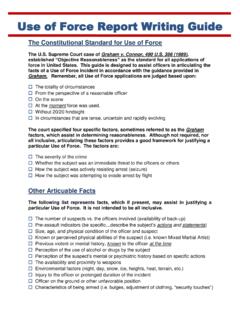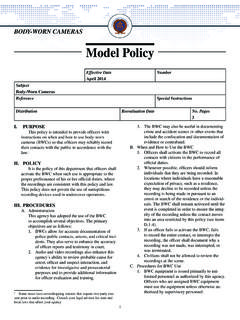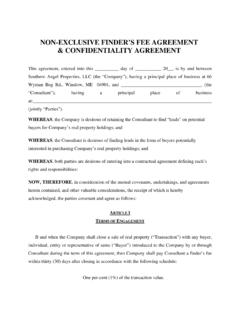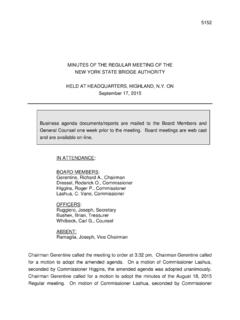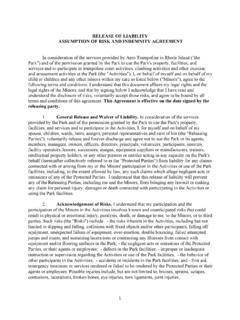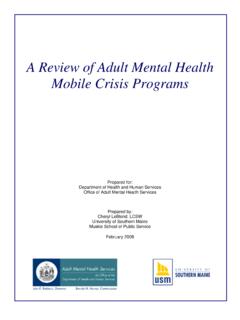Transcription of Minimum Staffing: Firefighters & EMS - AELE
1 AELE Home Page Publications Menu Seminar Information Cite as: 2010 (9) AELE Mo. L. J. 201. ISSN 1935-0007. Employment Law Section - September 2010. Minimum staffing : Firefighters & EMS. Contents Introduction General duty to bargain OSHA requirements states are not in agreement Sampling of state holdings Past practices Enforcement remedies References Introduction The July 2010 issue addressed Minimum standards for law enforcement and correctional agencies. As mentioned in the earlier article, staffing can be established by ordinance, budget appropriations, a bargaining agreement , or imposed by an arbitrator who resolves an impasse between management and a certified bargaining unit. Traffic accidents have caused injuries and deaths to all types of first responders. While police and correctional officers are more likely to suffer intentional harm, Firefighters and paramedics are more prone to accidental injuries and death due to structural failures, flashovers, backdrafts, asphyxia and other calamities associated with fire suppression and rescue operations.
2 [1]. General duty to bargain Currently, 36 states , Puerto Rico and the District of Columbia have a public sector employment labor board or commission, commonly referred to as PERBs. In the 14 states 201. that do not, collectively bargaining rights often exist for select occupations. Typically, units of local government have an option to create or enlarge bargaining rights. In those jurisdictions with bargaining, management is required to negotiate with a Firefighters ' union on terms and conditions of employment, provided the topic is a mandatory subject of bargaining. In the fire service, primary staffing requirements concern the number of Firefighters on a shift and the number who should respond to defined tasks. Secondary requirements often address the number of Firefighters assigned to individual stations and to various vehicles during each shift.
3 The primary requirements have a direct impact on employee safety and are likely to be declared a mandatory subject of bargaining. The secondary requirements are typically a managerial decision, but may be a permissive subject of bargaining. However, the unilateral diminution of staff assigned to a rig or station might impair a recognized past practice of the parties. OSHA requirements The Occupational Safety & Health Administration has a two-in, two-out rule. A fire service has a duty to provide two indoor Firefighters , who must remain in visual or voice contact with one another at all times, plus at least two employees who are located outside the danger zone. All employees engaged in interior structural firefighting must use a SCBA. Ref. (g)(4) Procedures for interior structural firefighting.
4 OSHA currently applies to federal and private Firefighters /EMTs, plus state and local government personnel in the 27 states and territories that operate OSHA-approved state plans (OSHSPA). Although law enforcement and correctional activities are fraught with life-threatening hazards, there are no OSHA-mandated Minimum staffing requirements for those occupations. The National Fire Protection Association also mandates a Minimum of four Firefighters for structural fires. [2] While the NFPA is a private-sector nonprofit association, its standards are highly respected and are often incorporated into fire codes, fire marshal regulations and bargaining agreements. 202. states are not in agreement Each state labor board or commission decides what is or is not a mandatory subject of bargaining.
5 During the negotiation process, management might agree to bargain a non- mandatory topic, in exchange for concessions from the union on unrelated matters. State PERB members are typically appointed by the Governor, and a majority of the members are frequently from the same political party. Perhaps this is why some boards have reversed prior rulings. Unlike courts, they are not bound by stare decisis, the doctrine of binding precedent. Whereas staffing is usually a management prerogative, safety is always a mandatory subject of bargaining. But simply labeling a staffing dispute as a safety demand does not make it so. Sampling of state holdings The following is a sample of past judicial or labor board decisions. Subsequent rulings may have superseded the holdings. They are mentioned only to illustrate the variety of results.
6 California An appellate court wrote that because of the nature of fire fighting, a reduction of personnel may affect the fire fighters' working conditions by increasing their workload and endangering their safety in the same way that general manning provisions affect workload and safety. A proposal that a staffing schedule currently in effect be perpetuated, without change, was arbitrable to the extent that it affects the working conditions and safety of the employees. Fire Fighters Local 1186 v. City of Vallejo, #23098, 12 Cal. 3d 608, 526 971 (1974). Maine A city was not required to bargain over the number of Firefighters on a shift or truck;. safety depends on manpower at a particular task. Portland Firefighters Assn. L-740 IAFF. v. City of Portland, 478 297 (Me. 1984). 203. Massachusetts A Superior Court overturned an arbitration award that established Minimum staffing levels for city fire department.
7 staffing is a management prerogative. Chelsea Firefighters Assn. L-937 v. City of Chelsea, Suffolk Co. Super. Ct. #91-4334-F, 30. (BNA) 342 (2/20/92). Michigan An appellate court ordered a fire chief to bargain with union over reduction of number of Firefighters on duty each shift in City of Trenton v. Trenton Firefighters ' Union, L-2701, 420 N. W. 2d 188 (Mich. App. 1988). In the following year a city was required to bargain over staffing cut from 3 to 2 Firefighters per shift. City of Manistee v. L-645, IAFF, 435. 778 (Mich. App. 1989). Also see City of Detroit v. F/F Assn., 204 Mich. App. 541, 517 240 (1994) and Trenton v. Trenton F/F Assn., 166 Mich. App. 285. (1988). New Jersey A firefighter's union may arbitrate its safety concerns, but may not challenge the employer's staffing decisions.
8 Town of Harrison v. FMBA Local 22, #2004-31, 29. NJPER 162 (NJ PERC 2003). The Commission previously held that bargaining agreement provisions setting Minimum staffing requirements for particular fire apparatus or establishing a Minimum complement of Firefighters and superior officers were not mandatorily negotiable. City of Long Branch and NJ FMBA Local 68, #92-102, 18 NJPER 175 (NJ PERC 1992). Also see, City of East Orange and L-23 Firemen's Benev. Assn., PERC #81-11, Docket #SN-80-61 (NJ. PERC 1980). New York An appellate court in New York wrote that a union may not force management to negotiate general questions of manpower deployment under the guise of safety. The Minimum number of Firefighters assigned to each piece of equipment or the number to be sent to each fire is clearly within the scope of managerial discretion.
9 The panel went on to hold that the question of how many Firefighters are necessary, from a safety standpoint, to handle a particular piece of equipment, is negotiable insofar as it impacts on the safety of Firefighters . IAFF, City of Newburgh v. Helsby, 399 334, 59 342 (1977). 204. Oregon The state labor board ruled that rig manning is a mandatory subject of bargaining, and is not a managerial prerogative. The holding was confirmed by an appellate court panel. IAFF L-314 v. City of Salem, Case #C-61-83, Ore. Emp. Rel. Bd. (1983); aff'd, #A29314, 68 793, 684 605 (1984). Pennsylvania In Pennsylvania, a three-judge appellate panel concluded that the safety of a firefighter is far more rationally related to the number of individuals fighting a fire with him, or operating an important piece of equipment at a fire, than it is to the number of members of the entire force.
10 IAFF L-669 v. City of Scranton, #2325 1979, 59 Pa. Commw. 235, 429 779 (1981). A year later, the same court held, that the number of Firefighters per rig affects safety and is proper subject of bargaining. City of Erie and IAFF L-293, 459 1320 (Pa. Cmwlth. 1982). Rhode Island In Rhode Island, the number of Firefighters on duty at a given time at a specific fire station was held to be arbitrable under the state's Fire Fighters' Arbitration Act. Town of Narragansett v. IAFF L-1589, 380 521 ( 1977). Washington state The state's supreme court wrote that When staffing levels have a demonstratedly direct relationship to employee workload and safety, however, we believe that, under appropriate circumstances, requiring an employer to bargain over them will achieve the balance of public, employer and union interests that best furthers the purposes of the public employment collective bargaining laws.





